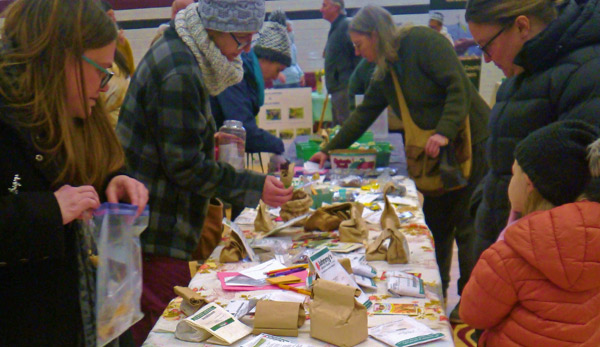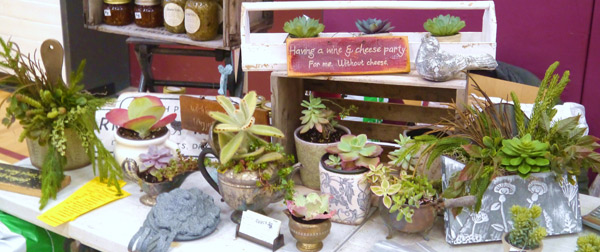Seedy Saturday continues to plant ideas and grow interest in its 15th year
Administrator | Feb 25, 2024 | Comments 0
Story and photos by Sharon Harrison
For many growers and gardeners – whether newbie or experienced – the apparent endless number of adoringly colourful seed packet offerings (and loose seeds) were akin to shelves of candy jars in a candy store – and the temptation just as irresistible.
Let’s just say, it’s a thing gardeners understand, the thought of a Saturday in February devoted, and related to, growing things, and especially the idea of swapping seeds.
Of course, Seedy Saturday isn’t just about seeds, where the event centres around education, the sharing of resources and information, but also catching up with neighbours and friends. It’s a celebration of gardens and gardening, the imminent arrival of spring and the upcoming gardening season, and of community, because it is community and volunteers that ensure Seedy Saturday’s success year after year.
Saturday’s event held at Prince Edward Collegiate Institute gymnasium on Barker Street in Picton, always a much-anticipated, is also good at lifting spirits during the middle of winter, where the anticipation of spring is within reach, and has many planning their gardens and formulating growing plans (especially with such a mild winter, so far).
While there was a donation jar at the door, the grassroots, volunteer-run annual event –now it its 15th year- remains free of charge, where even the enormously-varied and abundant donated seed tables were free for the taking (donations also welcome there).
The idea behind the seed swap tables is to bring seeds to leave behind for others to enjoy, pick up a few (or a lot) of seeds in return, but of course, you can still take, even if you don’t give (this is a good reminder to save seeds this year to bring to next year’s Seedy Saturday).
But there was no question, the rush of seed seekers was pure delight to witness for the many hunting for something a little out of the ordinary to grow in their gardens this year.
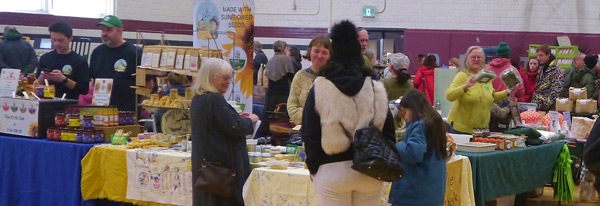 The event also welcomed local producers and farmers (food and other products (made, grown, raised)), along with some heritage seed vendors.
The event also welcomed local producers and farmers (food and other products (made, grown, raised)), along with some heritage seed vendors.
There were veggies for purchase, honey, herbal teas, a few house plants, along with beeswax candles, even hot water bottle covers made from 100 per cent Amherst Island sheep wool.
Local groups were represented and included the Prince Edward County Master Gardeners, the County Garden Club and the Ameliasburgh Garden Club, among them.
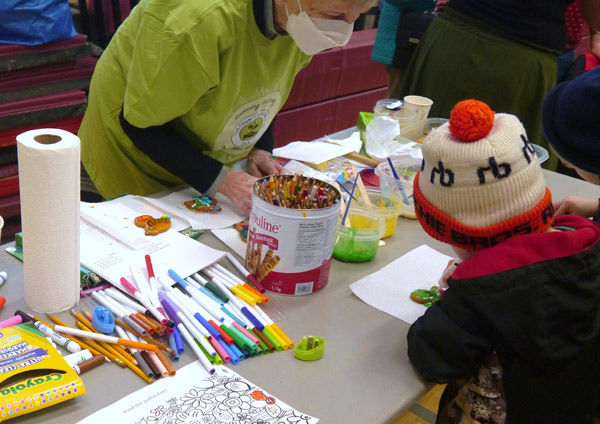 A kids’ corner kept the little ones busy for a while, whether it was learning how to pot up a small house plant, colouring, or decorating cookies.
A kids’ corner kept the little ones busy for a while, whether it was learning how to pot up a small house plant, colouring, or decorating cookies.
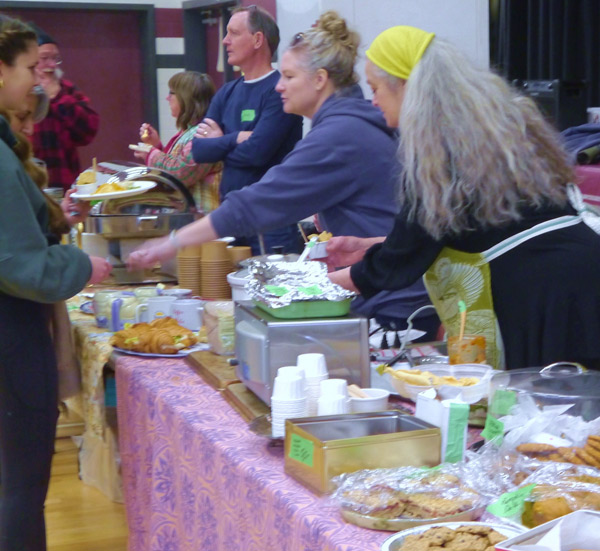 A fine menu of lunch offerings, including snacks, was available courtesy of Ruth Gangbar and her team, who were accepting donations for the County Food Hub.
A fine menu of lunch offerings, including snacks, was available courtesy of Ruth Gangbar and her team, who were accepting donations for the County Food Hub.
Three presentations (all free of charge) throughout the morning and afternoon – each very well attended – included information on naturalizing your yard with Ewa Bednarczuk who is with the Nature Conservancy of Canada.
She went over the methods of turning a grass lawn into a pollinator-friendly native plant haven. She also covered the County bylaw situation in her talk.
The second presentation of the day was about biochar, where Hans Ning of Paper Kite Farm based in the County explained what it is, how to make it, and why it is beneficial as a soil amendment, describing it as “exploring the potential of an ancient solution”.
Ning explained biochar used in the soil works in a similar way as many jug water filters work as they use carbon to filter out the bad stuff.
He explained how he uses biochar on their small family farm (where he explained how they make it and how anyone can do so) in their soil mixtures for seed starting.
He said biochar is great for soil structure, as it makes the soil nice and fluffy, reduces clumping, and retains water, and holds nutrients well.
“At a microscopic level, charcoal, which is mainly pure carbon, is extremely porous, and is extremely effective at holding particulates of all kinds within them,” he said. “It holds these particulates so well that they basically stay put in those pores.”
He explained that by taking advantage of the properties of charcoal, they become an extremely effective soil amendment that not only helps plants grow, but can become part of the solution in addressing the growing climate crisis.
“When adapted to use in agriculture, it is called biochar.”
Ning also spoke to how biochar is a good replacement for peat moss, something he said we should not be using or buying, given how it is not sustainable and “harvesting it is extremely dangerous to the ecosystem because it releases carbon into the atmosphere”.
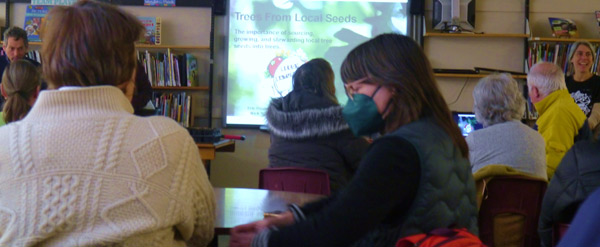 The final presentation of the day was all about starting trees from seed, and not just any seeds, but seeds gathered from mature (old growth) local trees, where their integrity and genetics are strong.
The final presentation of the day was all about starting trees from seed, and not just any seeds, but seeds gathered from mature (old growth) local trees, where their integrity and genetics are strong.
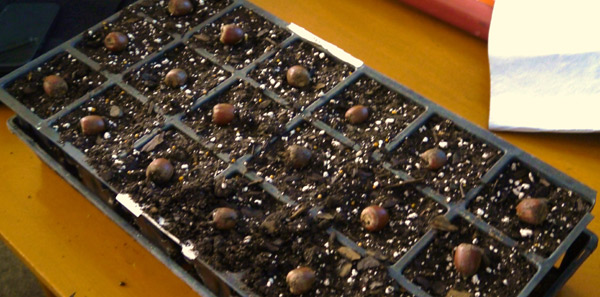 Nick Sorbara and Eric Davies spoke to the importance of replenishing the local eco-system with the right kind of tree seeds.
Nick Sorbara and Eric Davies spoke to the importance of replenishing the local eco-system with the right kind of tree seeds.
Sorbara spoke to the decline of tree diversity and the state of native trees in the County. The presentation also looked at making a restoration plan, and identifying habitat type, stewardship, and seed sourcing.
One audience question asked about “assisted migration”, something Davies described as a “really dangerous idea” where some people are attempting to create an eco-system by anticipating what the local eco-system may look like 100 years from now (anticipating much warmer temperatures and water) by bringing species and seeds, from say the southern United States, to plant in eastern North America.
Davies said this was problematic because no one knows what the eco-system will be like a hundred years from now.
“They have no idea what they are talking about, they have no idea what the eco-system is going to do, and they are only bringing up small handfalls.”
“Growing trees from local areas is best as they are better at adapting to their environment,” added Sorbara.
“The best thing to do to stop it from being messed up is to plant local trees,” he continued. “They say if each person can plant six trees a year, we could stop universal global warming.”
Filed Under: Arts & Culture • cheers • Featured Articles • News from Everywhere Else
About the Author:



